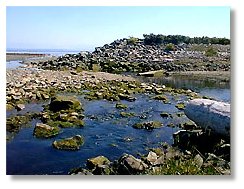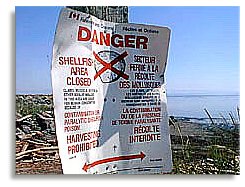The Nutrification of our Waters
By Damien Barstead
Do you enjoy eating freshly picked shellfish, swimming at your favorite beach, or maybe enjoy good drinking water? Most people enjoy clean water in some capacity, but often do not realize how local streams influence some of the most productive fresh and tidal waters.
One of the largest contaminants in surrounding waters is fecal colliform growth.

Heavy doses of nutrients that reach the ocean can promote excessive growth of algae and other organisms
Fecal colliforms spread from feces that have made its way into the creeks and rivers. The main contributors to this harmful problem are:
- Cattle and other livestock that have access to a stream:
- When horses, cattle, chickens, and other animal are concentrated near streams, they frequently end up polluting the water with feces, either directly, or indirectly through the ground into the water table.
- Improper manure management on farms:
- All too often, manure is stored and piled very close to nearby streams. It is left there to compost so that it can be used as fertilizer the following season. Fecal colliforms and nutrients make their way into the stream through run-off and ground water leeching during the rainy season.
- Faulty, damaged, or unmaintained septic systems:
- Many homes in urban areas are still using septic tanks and drainage fields to deal with their sewage. If functional, these systems work fine and pose little environmental threat. Unfortunately the majority of homes, especially in older neighborhoods, are using septic systems that are not being maintained. In these areas sewage is often washed directly into the drainage field as untreated waste because the septic tank is full. In addition, cracked tanks also cause problems by allowing drainage and leeching to go directly into the water table
|
What does this mean to us and the fish? Studies have shown that fecal pollution actually has little direct effect on fish such as salmonids or trout. The greatest effects felt are those related to the direct contamination of shellfish, and the indirect effects felt from the nutrification of streams.
Shellfish and other bi-valves are filter feeders, meaning they filter all of their food from the water. Consequently, they retain everything that is in the water, including the fecal colliforms.

Too many of our local beaches are being
polluted from undertreated residential and industrial waste.
This process is called bioaccumulation. Although not toxic to the shellfish, these fecal colliforms can prove to be fatal if the shellfish are eaten by humans!
Another related problem is that of nutrient loading, and its affect on streams and connected lakes. Although this is more common in lakes
surrounded by development, the high levels of nutrients associated with
fecal colliforms effect streams in a similar way. Nutrient loading promotes the growth of many organisms, as well as large algal mats. Algal mats often block sunlight from penetrating the water causing plants and organisms to die, decompose, and settle. Ultimately the end effects of this are, less oxygen and less light in the system, both of which are critical to a healthy, productive system.
Both farms and septic systems contribute to the growing problem of fecal colliforms in our waters. Fortunately both of these can be improved with a little money and commitment to fixing them. Simple things such as composting away from water sources, building bridges and fencing off streams, as well as having your septic system inspected and pumped regularly, will contribute to a cleaner environment for the fish and people.
Top of page.
|

